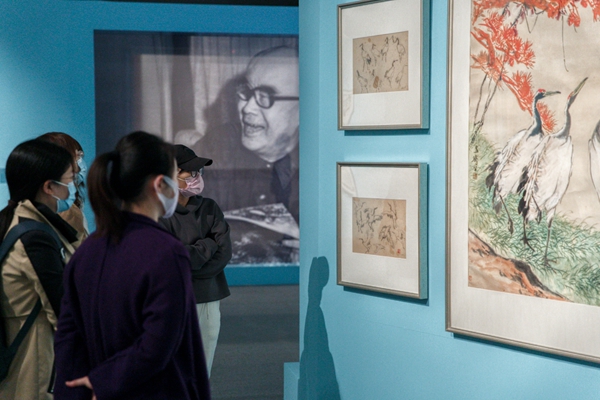Exhibition showcases an artist's lifelong endeavor to inject modernity into classical paintings in 20th-century China, Lin Qi reports.
The late master of classical Chinese paintings Qi Baishi once said he often felt that one of his hands had been "stolen" by his student Wang Xuetao (1903-82).
Qi was known for his accurate depictions of insects such as butterflies, crickets and dragonflies, and the vivid details of the insects' wings and heads stand out in his paintings. While Wang was studying at the Beijing Fine Arts School in the early 1920s, he picked up Qi's excellent brushwork. The school is now known as the Central Academy of Fine Arts.
Wu Hongliang, head of the Beijing Fine Art Academy, says Qi joked that Wang had such good skills that it was as if Wang used his fingers to paint.
Decades later, Wang followed his teacher's footsteps to become one of the leading artists in the flower-and-bird genre of classical Chinese paintings, and also became head of the Beijing Fine Art Academy.
The flower-and-bird genre is one of three major categories in Chinese ink painting. They are well received by the public for lively scenes of different animals and flowers in diverse palettes.
Wu likes the portrayal of small insects in Wang's work. "The subtle way he administered the brush and the refinement in how he completed the strokes-it all feels so gorgeous. Not overly done, but quite appropriate," Wu says.
"I believe Qi must have felt the same way and that was why he spoke highly of Wang's works."
The lingering charm of an animated world under Wang's brushstrokes is the center of Vitality and Joy, an exhibition at Beijing's National Museum of China until June 30.
The gathering of collections from the National Museum, Beijing Fine Art Academy and the Wang Xuetao Memorial in Jinan is dedicated to Wang's lifelong endeavor to usher the longstanding tradition of flower-and-bird paintings into 20th-century China.
During Wang's years at the Beijing Fine Arts School, oil paintings and watercolors were gaining widespread popularity. In that same period, classical Chinese art was losing touch due to its confinement to rigid rules throughout the centuries.
Wang, who majored in oil painting, also took courses by great ink painters like Qi and Wang Mengbai. He was drawn to the beauty and poetry sense of the classical art and gradually established fame in the realm of Chinese paintings.
Wang revived the art by preserving the best of it while adopting elements of Western art.
"His brushwork is alive and clean. He was able to capture the lively moments of an animal, or a flower. It is as if these subjects became animated on paper," says Liu Wanming, deputy director of the National Museum of China and curator of Vitality and Joy.
"We can see from these works that Wang loved life and all things in the universe. His paintings present an atmosphere, a high spirit-above all figurative depictions-which is considered superior in Chinese paintings."
Wang learned a great deal from several master painters of ancient China. Zhu Da, also known by his pseudonym Bada Shanren, was one painter he admired greatly.

